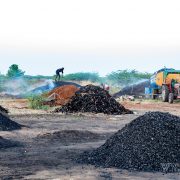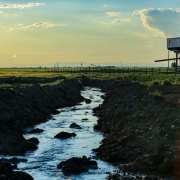In Idaho Wilderness, A Clash Over Water Quality and National Security
U.S. edges closer to approving big antimony and gold mine.

The Yellow Pine Pit is where mining would begin in the Stibnite Gold Project, at the headwaters of a major tributary of the Salmon River. © Katherine Ergil / Circle of Blue
By Katherine Ergil, Circle of Blue – December 10, 2024
YELLOW PINE, IDAHO – The deep forests and steep canyons of this state are no strangers to confrontations between the prodigious revenue earned and massive ecological harms from hard rock mining.
Now a plan to reopen a big, old, and long shuttered hard rock mine on federal land in a sensitive watershed near this town of 40 residents, a jumping off encampment to a popular wilderness, is drawing closer to approval. The U.S. Forest Service in September issued a draft record of decision that authorized Boise-based Perpetua Resources to reopen the Stibnite Mine in the Payette National Forest. The final decision to develop one of the largest gold, silver and antimony mines in the United States could come before the end of the year.
But even as mine executives and a coalition of environmental activists clash over the prospect of a big mine in their midst, it’s also apparent that two critical factors influenced the government’s decision.
One is Perpetua’s pledge to develop ecologically sound mining practices, while also using mineral revenues to protect streams and clean up a century of mine waste on the 3,200-acre site.
A second is the development of a domestic supply of antimony, a strategic mineral used in clean energy equipment and national defense. The U.S. relies entirely on antimony produced by other countries, especially China, which supplies roughly half of the world’s antimony. Reacting to President-elect Donald Trump’s promise to levy tariffs on imports, China in mid-September announced it will cut off the global supply of antimony to protect its own national security.
“Our independence from Chinese control over antimony is right here in our backyard,” said Jon Cherry, Perpetua Resources’ chief executive in a statement.
But the amount of antimony is small in comparison to almost $8 billion of gold anticipated from new mining. “It’s just a three-year supply. That’s not going to solve our problems,” countered Nick Kunath, director of Idaho Rivers United Conservation. “This mine is going to operate for 15 years. Antimony kind of comes in different waves. Then what? Where are we going to get the antimony after this? “
“We need to look at projects that make sense from risk versus reward. This one is pretty much all risk as far as the environment goes. The reward is via shareholders.”
Mary Faurot Petterson, a former fish biologist and district ranger in the Payette National Forest and board member of Save the South Fork Salmon and Idaho Conservation League, said area residents are determined not to allow the behavior of the mine’s previous owner. “They left in the dark of the night leaving a huge mess at Stibnite with water quality problems, channelized water streams, problems with tailings, poisonous, toxic tailings leaking into the headwaters of the East Fork of the South Fork.”

From a project road looking at HECLA heap tailings storage and the adjacent pool containing the runoff from the stored tailings that is collected and evaporated to prevent contamination of streams and groundwater. ©Katherine Ergil / Circle of Blue
A Damaged Landscape
Located on the edge of the Idaho backcountry, the Stibnite Mine is the centerpiece of a 125-year-old mining camp, declared a national historic site in 1987, and set at the headwaters of the East Fork of the South Fork of the Salmon River.
In 1899, the first claims were made in the area by miners during the Thunder Mountain gold rush. This was the beginning of underground and open pit mining in the Stibnite/Yellow Pine District, accompanied by homesteads and eventually towns.
With intermittent mining occurring throughout the 20th century the Stibnite mines left their mark. The region received recognition as the largest producer of strategic metals for the United States Army during World War II with the discovery of tungsten in the area. The mine was credited with shortening the war by a year and saving the lives of “a million American soldiers,” in a 1956 Congressional statement.
After a post-war shutdown and a reopening for another round of mining, conditions continued to deteriorate with little accountability for cleanup efforts. “The courts found that the government was 80 percent responsible for a lot of that legacy contamination because a lot of the work at the project site was done to support the war effort in WWII, to get a lot of those critical minerals” explained Kyle Fend, the field operations manager for Perpetua Resources.

Atop of a mound of old mining waste signs detail some of the proposed work of Perpetua Resources in the Stibnite mining district. Moving and managing old mining waste known as tailings to more securely keep this waste from leaching into the Salmon River Watershed. © Katherine Ergil / Circle of Blue
A Modern Proposal
Signs along the roads leading to the Stibnite detail changes promised by Perpetua to expand fish habitat and restore wetlands and other natural features damaged by more than a century of mining. “If you can find someone that’s going to spend a hundred million dollars to be able to go in and do the restoration work up there, bring them forward. But it’s been 80 years, and no one’s come forward” said Fend.
When the most recent mining at Stibnite ended in the 90’s the site was eligible to become a Superfund under the 1980 Comprehensive Environmental Response, Compensation, and Liability Act (CERCLA). The work eventually slowed due to political decisions and lack of funding.
“Millions and millions of dollars were spent,” said Petterson. “The Nez Perce tribe was also very instrumental in getting some of this work done and I personally did a lot of testing on macroinvertebrates and sediments and waters and fish to determine where and what levels of contamination were happening even though there was no more mining happening.”

Constructed stream meanders below the tailings facilities intended to mimic the natural movement of water in critical salmon habitat interrupted by previous mining projects © Katherine Ergil / Circle of Blue
Water Quality Concerns
Fend of Perpetua has been on the project since 2013 and describes the site’s relationship with conservation groups, “We’re their favorite mining company with the project in the least favorite location” he says.
Currently water testing done by Perpetua Resources shows elevated levels of arsenic and antimony in ground and surface water surrounding the mining area. Though reclamation efforts detail plans to improve these conditions. The Final Environmental Impact Statement (FEIS) and Draft Record of Decision (ROD) show that the water quality will first decrease majorly during mining operations.
In a 257-page objection letter signed by eight conservation groups against the current project plan, aqueous geochemist Ann Maest cites data of the “predicted maximum antimony concentrations in the water treatment plant influent” and describes them as “the highest I have ever seen in my many years of working on mine water chemistry”
Though plans are in place to clean these waters the question remains if the region can handle pollution in a manner that will allow for restoration.
“We’re concerned about air quality impacts, the ability for them to reclaim the site because of really high metal concentrations in the soils and the fact that they don’t have enough clean soil to complete the reclamation as proposed” says Bonnie Gestring, the Northwest Programs Director at Earthworks.

In addition to the mining putting waste into the Salmon River Watershed, there are concerns about heavy traffic from the projects leading to spills and kicking dust and debris into the river. © Katherine Ergil / Circle of Blue
The Missing Alternative
In the environmental assessment released by the Forest Service two notable absences stuck out to conservation groups: a range of alternatives and climate change.
“Because of the longevity of the mine and the significant changes we’re seeing as part of climate change, all of that really needed to be considered. Increased rate and severity of storms; not factored. All of these things that would lead to better, safer, mining practices were not considered.” says Gestring.
The other absent feature in the FEIS were any alternatives to doing the projects as proposed. “The NEPA process is supposed to provide a range of alternative where they look at a range of more environmentally protective ways of doing the project or limit the scale of the impact,” said Gestring.
“Our economy is thriving because of our natural resources” points out Petterson, “It’s beautiful, there’s public land, there’s wilderness, there’s wildlife, there’s relatively clean water and clean air.”
Perpetua responds that its vow to mine with an eye to restoration is sincere. It looks as though the company will have the chance to prove it. “We can go in and redevelop a site,” said Fend. “We can use some of the profits to do the restoration work to return the site to a better condition moving forward.”
Kat is a reporting intern at Circle of Blue and a student at Northwestern University. She is a fourth-year student studying Earth & Planetary Sciences and Journalism with a strong interest in building an understanding of hydrologic systems to report on environmental, water and climate change stories.













Crazy Stuff! Very informative!